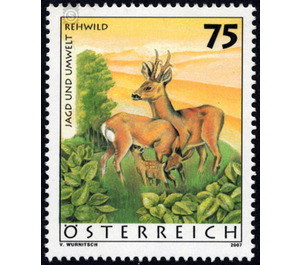Hunting and environment - Austria / II. Republic of Austria 2007 - 75 Euro Cent
Theme: Animals
| Country | Austria / II. Republic of Austria |
| Issue Date | 2007 |
| Face Value | 75.00 |
| Edition Issued | 500,000 |
| Printing Type | Photogravure |
| Stamp Type | Commemorative |
| Item Type | Stamp |
| Chronological Issue Number | 1976 |
| Chronological Chapter | OOS-OE2 |
| SID | 285022 |
| In 54 Wishlists | |
Roe deer is the smallest and most common deer species in Europe. In the lowlands as in the high mountains, also in the north of Scandinavia and in the east as far as Siberia the deer is to be found. The mosaic structure of our landscape, mixed agricultural and forestry areas, offers favorable habitat for roe deer. From the body it can be used particularly well underwood-rich Waldrandzonen. As a pronounced cultural successor, the deer comes close to human settlements. Characteristic of the roe deer, which counts to the order of the cloven-hoofed animals, are the high runs with narrow, sharp-edged shells. The coat (the "blanket") is reddish brown in summer and gray-brown in winter with a white spot at the back end, which is called "mirror" by the hunters. This serves as an orientation for the kittens (fawns) and the following pack in the event of an escape. Deer are actually color blind, but register movements very closely. They smell and hear very well. Only the buck is a horn carrier. As a ruminant, the deer is a pure herbivore, it prefers nutrient- and high-energy plant parts, such as herbs, grasses, leaves, shoots and buds. For food intake especially the twilight time is used in the morning and in the evening. However, the demand for food quality leads to a high level of population density of the roe deer and thus to a high level of contamination of the vegetation and thus to damage in agriculture and forestry. The time of reproduction in roe deer is in the months of July-August and is also called leaf or rutting season. After fertilization, a 4-month dormancy occurs, only in December, the fertilized egg cell continues to develop. After about 22 weeks, which is towards the end of May, the roe deer usually has two fawns. In the first days of life the mother animal visits the fawns only for suckling, in order to lure no predators on the trail of the young animals, which are well camouflaged in their white spotted fur and motionless in the grass. Only after 2-4 weeks, the fawns are able to flee from enemies such as fox and badger or from dangers such as mowers. During the four days of the trade fair for hunting, sport, weapons, fishing and four-wheelers, the JASPOWA, interested visitors can take a look at all the news on hunting, fishing, shooting and off-road travel. inform. This showcase of domestic hunting is not only of great interest to hunters, but also brings the hunting use of native wild animals in their habitats closer to non-hunters.


